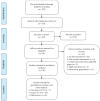Epidemiology of Cerebral Palsy among Children and Adolescents in Arabic-Speaking Countries: A Systematic Review and Meta-Analysis
- PMID: 35884667
- PMCID: PMC9313288
- DOI: 10.3390/brainsci12070859
Epidemiology of Cerebral Palsy among Children and Adolescents in Arabic-Speaking Countries: A Systematic Review and Meta-Analysis
Abstract
Background: Studies on cerebral palsy among children and adolescents in Arabic-speaking countries are scarce. In this systematic review, we aimed to describe the epidemiology of cerebral palsy among children and adolescents in Arabic-speaking countries in terms of prevalence, risk factors, motor types, and rehabilitation.
Methods: Six key bibliographic databases were searched for relevant literature published to 17 July 2021. Titles and abstracts were screened for potential inclusion and two independent reviewers screened the full texts of potential articles following pre-defined inclusion/exclusion criteria. The included studies were evaluated independently by three reviewers. The risk of bias was assessed, and data were extracted and analysed.
Results: A total of 32 studies from 7 countries met our inclusion criteria. The prevalence of cerebral palsy in Arabic-speaking countries was 1.8/1000 live births (95% CI: 1.2-2.5). Spastic cerebral palsy was the most common motor type, representing 59.8% (95% CI: 46.2-72.7) of pooled estimates. This included children with spastic quadriplegia, diplegia, and hemiplegia; 25.1% (95% CI: 18.2-32.8), 16.2% (95% CI: 11.4-23.3), and 10.4% (95% CI: 7.3-13.8), respectively. Consanguinity was high and represented 37.7% (95% CI: 29.3-46.6). Only one included study reported the types of rehabilitation received (e.g., physiotherapy and assistance devices).
Conclusions: This paper provides a summary of the epidemiology of cerebral palsy in Arabic-speaking countries and highlights areas for future research. There is still a substantial knowledge gap on the epidemiology of cerebral palsy in these regions. Countries in the Arab region should follow examples of countries that have successfully established cerebral palsy registries to generate evidence on epidemiology of cerebral palsy and opportunities for prevention.
Keywords: Arab; Arabic-speaking countries; adolescents; cerebral palsy; children; epidemiology.
Conflict of interest statement
The authors declare no conflict of interest.
Figures





References
Publication types
LinkOut - more resources
Full Text Sources
Miscellaneous

